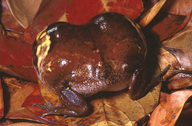|
Description
Kaloula pulchra ranges in size from 54-70 mm SVL for males, and 57-75 mm SVL for females. The body is stocky, with a small head and short, rounded snout. This frog will inflate itself when threatened.
The dorsum is dark brown, sometimes with irregular yellowish-brown spots. A narrow dark lateral stripe is present from the rear of the eye almost to the groin. This lateral stripe is separated from the mid-dorsal dark brown coloration by a thick yellow or orange stripe, which may itself be punctuated with several spots. The belly is mottled dirty yellowish brown. Males have a black throat. Distribution and Habitat
Country distribution from AmphibiaWeb's database: Bangladesh, Cambodia, China, Hong Kong, India, Indonesia, Lao People's Democratic Republic, Malaysia, Myanmar, Nepal, Singapore, Thailand, Viet Nam. Introduced: Philippines. Malaysian region distribution from AmphibiaWeb's database: Peninsular Malaysia, Sabah
This species is found in Bangladesh, Cambodia, China, Taiwan (introduced), Hong Kong, India, Indonesia, Lao People's Democratic Republic, Malaysia, Myanmar, Nepal, Singapore (introduced), Sri Lanka, Thailand, Viet Nam, Guam (introduced), and the Philippines (introduced) (Lazell and Lu 1996; Christy et al. 2007). It is found in wetland, riverbank, and forest edge habitats, as well as agricultural and residential areas, at elevations up to 750 m a.s.l. It breeds in seasonal rain pools or ponds (Kuangyang et al. 2004). Life History, Abundance, Activity, and Special Behaviors
Generally breed during rainy season; males are usually heard during and after rainfall. They otherwise hide under burrows or vegetation and are nocturnal (Emerson 1976). Calls can be given while males float on the water surface. Calling is usually in chorus; however, adjacent calling males may alternate their calls (Kanamadi et al. 2002).
These frogs prey on ants (Berry 1965).
K. pulchra can exude highly sticky secretions, which are most likely used to deter predators (Evans and Brodie 1994). These secretions are noxious (unpleasant tasting) but did not contain detectable levels of toxins when tested (Daly et al. 2004). Trends and Threats
This frog is adaptable and appears to be increasing in numbers (Kuangyang et al. 2004). Relation to Humans
Kaloula pulchra is collected for local consumption as well as the international pet trade. It has been accidentally introduced to several countries (e.g., Guam), presumably via maritime or air-transport vessels and the pet trade. One specimen was discovered at the Perth airport in 2005 (Tyler and Chapman 2007), and one found in cargo at a New Zealand wharf (Gill et al. 2001), but there are no records showing the species has become established in either Australia or New Zealand. It often takes advantage of urban environments where it can be quite abundant (Kuangyang et al. 2004).
References
Berry, P. (1965). ''The diet of some Singapore Anura (Amphibia).'' Proceedings of the Zoological Society of London, 144, 163-174.
Christy, M., Savidge, J., and Rodda, G. (2007). ''Multiple pathways for invasion of anurans on a Pacific island.'' Diversity and Distributions, 13(5), 598-607.
Daly, J. W., Noimai, N., Kongkathip, B., Kongkathip, N., Wilham, J. M., Garraffo, H. M., Kaneko, T., Spande, T. F., Ninit, Y., Nabhitabhata, J., and Chan-Ard, T. (2004). ''Biologically active substances from amphibians: preliminary studies on anurans from twenty-one genera of Thailand.'' Toxicon, 44, 805-815.
Diesmos, A.C., Diesmos, M.L., and Brown, R.M. (2006). ''Status and distribution of alien invasive frogs in the Philippines.'' Journal of Environmental Science and Management, Philippines, 9, 41-53.
Emerson, S. (1976). ''Burrowing in frogs.'' Journal of Morphology, 149(4), 437-458.
Evans, C. M., and Brodie, E. D. Jr. (1994). ''Adhesive strength of amphibian skin secretions.'' Journal of Herpetology, 28, 499-502.
Gill, B. J., Bejakovich, D., and Whitaker, A. H. (2001). ''Records of foreign reptiles and amphibians accidentally imported to New Zealand.'' New Zealand Zoology, 28, 351-359.
Kanamadi, R. D., Kadadevaru, G. G., and Schneider, H. (2002). ''Advertisement call and breeding period of the frog, Kaloula pulchra (Microhylidae).'' Herpetological Review, 33(1), 19-21.
Kuangyang, L., Zhigang, Y., Haitao, S., Baorong, G., van Dijk, P. P., Iskandar, D., Inger, R., Dutta, S., Sengupta, S., Sarker, S. U., and Asmat, G. S. M. (2004). Kaloula pulchra. In: IUCN 2009. IUCN Red List of Threatened Species. Version 2009.1. www.iucnredlist.org. Downloaded on 06 July 2009.
Lazell, J., and Lu, W. (1996). ''Geographic distribution. Kaloula pulchra pulchra.'' Herpetological Review, 27(4), 209.
Tyler, M. J., and Chapman, T. F. (2007). ''An Asian species of frog (Kaloula pulchra, Microhylidae) intercepted at Perth International Airport, Australia.'' Applied Herpetology, 4, 86-87.
Originally submitted by: Pierre Fidenci (first posted 2009-06-29)
Edited by: Kellie Whittaker (2009-07-06)Species Account Citation: AmphibiaWeb 2009 Kaloula pulchra: Asian Painted Frog <https://amphibiaweb.org/species/2157> University of California, Berkeley, CA, USA. Accessed Mar 28, 2025.
Feedback or comments about this page.
Citation: AmphibiaWeb. 2025. <https://amphibiaweb.org> University of California, Berkeley, CA, USA. Accessed 28 Mar 2025.
AmphibiaWeb's policy on data use.
|
